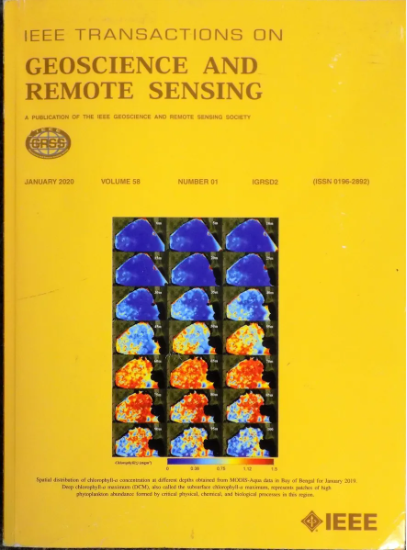Polarization-Based VLF Remote Sensing of Transient Ionospheric Disturbances
IF 7.5
1区 地球科学
Q1 ENGINEERING, ELECTRICAL & ELECTRONIC
IEEE Transactions on Geoscience and Remote Sensing
Pub Date : 2024-09-27
DOI:10.1109/TGRS.2024.3469381
引用次数: 0
Abstract
Very-low-frequency (VLF) (3–30 kHz) radio waves can propagate large distances around the globe in the Earth-ionosphere waveguide and be scattered by transient disturbances to the lower ionosphere. Such scattering enables the VLF remote sensing of lightning-related (as well as other) disturbances to the D-region ionosphere (60–100-km altitude). Indeed, recent work studying the polarization of VLF radio waves has yielded insights into the physical mechanisms associated with “large” early/fast VLF events, which are produced by powerful lightning discharges. While the polarization of the ambient VLF field has been investigated in such cases, the polarization of the field scattered by the ionospheric disturbance has not been investigated in detail, primarily because it can be difficult to measure. In this article, we present a simple, reliable method to accurately calculate the polarization of such a scattered field, and we apply the method to analyze three different types of ionospheric VLF scattering events: an early/fast VLF event, a long-recovery early VLF event, and a lighting-induced electron precipitation (LEP) event. In so doing, we demonstrate the significant advances in VLF remote sensing capabilities provided by the scattered field polarization method.基于极化的甚低频遥感瞬变电离层扰动
甚低频(VLF)(3-30 千赫)无线电波可在地球-电离层波导中绕地球传播很远的距离,并被低电离层的瞬时扰动所散射。这种散射使 VLF 能够遥感 D 区电离层(60-100 千米高度)与闪电有关的干扰(以及其他干扰)。事实上,最近对甚低频无线电波极化的研究工作已经深入了解了与 "大型 "早期/快速甚低频事件相关的物理机制,这些事件是由强大的闪电放电产生的。虽然在这种情况下对环境甚低频场的极化进行了研究,但对电离层扰动所散射的场的极化还没有进行详细研究,主要是因为它很难测量。在本文中,我们提出了一种简单可靠的方法来精确计算这种散射场的极化,并应用该方法分析了三种不同类型的电离层甚低频散射事件:早期/快速甚低频事件、长恢复早期甚低频事件和光诱导电子沉淀(LEP)事件。在此过程中,我们展示了散射场极化方法在甚低频遥感能力方面取得的重大进展。
本文章由计算机程序翻译,如有差异,请以英文原文为准。
求助全文
约1分钟内获得全文
求助全文
来源期刊

IEEE Transactions on Geoscience and Remote Sensing
工程技术-地球化学与地球物理
CiteScore
11.50
自引率
28.00%
发文量
1912
审稿时长
4.0 months
期刊介绍:
IEEE Transactions on Geoscience and Remote Sensing (TGRS) is a monthly publication that focuses on the theory, concepts, and techniques of science and engineering as applied to sensing the land, oceans, atmosphere, and space; and the processing, interpretation, and dissemination of this information.
 求助内容:
求助内容: 应助结果提醒方式:
应助结果提醒方式:


